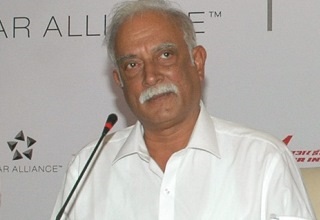Draft civil aviation policy geared to face new global & domestic demands
Updated: Nov 10, 2014 04:48:56pm

Releasing the Draft Civil Aviation Policy, Civil Aviation Minister, Ashok Gajapathi Raju Pusapati said, “It is a step towards making civil aviation a vibrant sector in our country, to rise to its full potential,” adding that the new Civil Aviation Policy is expected to be in place by January 2015, according to an official release.
The Draft has been released for consultation with public and stakeholders within three weeks, after which six to seven groups of experts would be constituted to interact with stakeholders and review the inputs received during the process.
Also speaking on the occasion, Secretary, Ministry of Civil Aviation, V Somasundaran highlighted the salient features of the Draft Civil Aviation Policy in terms of better services and conveniences to flyers.
The Draft notes that “airports are to be designed as integrated multi-modal hubs, so that they provide the best possible service levels as well as potential for growth. An integrated multi-modal hub should include rail, metro, bus and truck connectivity as well as accommodation and other services”, he added.
While developing airports, it is equally essential to ensure that related sectors such as access to manufacture, business, tourism and pilgrim centres are developed. This needs to be done in association with other Central Government Departments as well as the State Government/Union Territory, he said.
Further, the six metropolitan airports at Delhi, Mumbai, Chennai, Kolkata, Bangalore and Hyderabad would be developed as major international hubs and would in future be the main access points for international travel to and from India. In future a “hub-and-spoke” model would be followed, which would also facilitate the development of regional networks and air connectivity as a whole. The existing bilateral agreements with foreign bilateral agreements will be designed in such a way as to facilitate the hub-and-spoke model, the release said.
Significantly, the Draft puts emphasis on rationalizing the cost of Aviation Turbine Fuel (ATF). Due to high rates of taxes, the cost of ATF in India is 40 to 45 per cent higher than the international costs. Steps will be taken in association with the Ministry of Finance and State Governments to rationalize the rate of taxes so that our costs are competitive.
Regarding development of the cargo sector, the Government proposes to substantially develop the transport of cargo by air for which there is considerable potential. To achieve the objective, the six metro airports will be developed as regional cargo hubs, integrating multi-modal transport facilities, cold chains and other commodity specific requirements. The turnaround time for cargo will be upgraded to international standards. Air Freight Stations will be developed in different parts of the country to streamline Customs clearance and to reduce congestion in the airports.
As institutional reforms, an Expert Committee will be constituted to develop a future roadmap for Air India. Airports Authority of India will be corporatised, followed by listing in the Stock Exchanges, in order to improve efficiency and transparency. Pawan Hans Ltd. will be listed in the Stock Exchanges with the same objective. A mission mode project will be set up to ensure that organizations under the Ministry are competitive in terms of efficiency and costs.
Government’s objective will be to provide optimum air connectivity to all regions, subject to commercial viability. A special package will be developed for the North-Eastern Region to improve air connectivity and provide linkages to remote locations. The Route Dispersal Guidelines will be reviewed with the objective of encouraging Indian carriers to enhance regional connectivity through deployment of small aircrafts and code sharing arrangements. The 5/20 guidelines will be reviewed with a view to encouraging the entry of new Indian carriers.
For development of the civil aviation sector, provision of Air Navigation Services (ANS) of international standards is essential. The Airports Authority of India has taken several initiatives in this direction. These would be intensified with the objective of reducing flying time, elimination of crowding at airports, direct routing of aircrafts from destination to destination and enhancing communication and navigation services to international standards.
Helicopter Aviation is a segment that has considerable potential for growth in areas such as reducing congestion in the big cities, medical evacuation, relief operations, law and order, oil exploration etc. Heliports and helipads will be developed in locations with sufficient potential. It is also proposed to provide suitable incentives to helicopter operators in respect of operational costs in the airports. The rules and regulations followed by DGCA will be upgraded to international standards. Systems will be introduced for online receipt and clearance of various permissions and clearances.
The functioning of Ministry of Civil Aviation and the offices under the Ministry will be digitized to improve efficiency and transparency. The service and clearances to be given by different agencies will be made online. Electronic procurement systems will be strengthened to ensure transparency and accountability.
The Draft Civil Aviation Policy is also available on the website of the Ministry of Civil Aviation: civilaviation.gov.in. (KNN Bureau)












